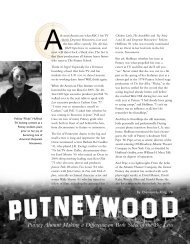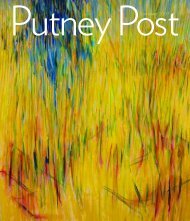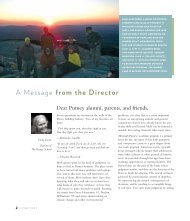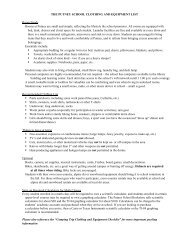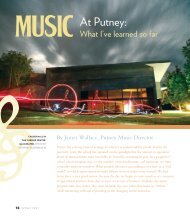Lucinda Parker McCarthy '60 - The Putney School
Lucinda Parker McCarthy '60 - The Putney School
Lucinda Parker McCarthy '60 - The Putney School
You also want an ePaper? Increase the reach of your titles
YUMPU automatically turns print PDFs into web optimized ePapers that Google loves.
Cover Artist<br />
<strong>Lucinda</strong> <strong>Parker</strong> <strong>McCarthy</strong> ’60<br />
By Don Cuerdon<br />
4 <strong>Putney</strong> post
<strong>Lucinda</strong> <strong>Parker</strong> <strong>McCarthy</strong> ’60,<br />
perhaps better remembered by<br />
classmates as “Cindy” (“My<br />
mother’s name was Lucy, so they<br />
called me Cindy,” says <strong>Lucinda</strong>)<br />
has a painting career that spans 68<br />
years, which made it that much<br />
harder for us to choose one for the<br />
cover of this issue. “A Glade of<br />
Many Ages” (2011) is a 10x20-<br />
foot mural commissioned by the<br />
University of Oregon in Eugene<br />
for their Ford Alumni Center. It<br />
is a work of art as much as it is a<br />
political statement and an experience<br />
for the viewer. In a phone<br />
conversation, <strong>Lucinda</strong> revealed<br />
some of what goes into creating<br />
such a work, and the personal<br />
history behind it.<br />
“A Glade of Many Ages”<br />
has five and a half trees in<br />
it. It’s very carefully set up<br />
with these zig-zaggy green<br />
shapes and then with straight<br />
ones. One of the things about<br />
deciding to paint trees is you<br />
have to deal with all those<br />
straight lines. If you’ve ever<br />
been in the Northwest, these<br />
trees are like any tree you’ve<br />
seen in New England, but on<br />
steroids. <strong>The</strong>y’re huge.<br />
As a painter, you have to<br />
worry about how you’re<br />
going to deal with the<br />
fact that you have a whole<br />
series of vertical shapes<br />
marching across your<br />
canvas. In this painting I<br />
made a big effort to open it<br />
up and to give the illusion that<br />
you’re seeing through to a<br />
series of maybe real horizons,<br />
or imagined horizons, and<br />
lines of clouds. A large part<br />
of it is explored ahead of<br />
time because it’s such a big<br />
painting—10x20-foot. So I<br />
did a beautiful raft of little<br />
gouache paintings to study<br />
this whole thing.<br />
You’re standing there and<br />
you get a physical experience<br />
just looking at it.<br />
It is big enough that you can<br />
imagine walking into it. That’s<br />
part of why I like doing big<br />
paintings. Part of it is that they<br />
can be seen over half a block<br />
away. And partly because it’s<br />
physically demanding and also<br />
it’s physically engrossing to<br />
look at them.<br />
I’ve always had a love<br />
of nature. I grew up outside<br />
of Boston in a small town called<br />
Wayland. At that time there<br />
were only 7,000 people in it.<br />
Wayland was really a rural place,<br />
not far from Walden Pond.<br />
I started painting when<br />
I was two years old, but<br />
I really got going painting<br />
when I was at <strong>Putney</strong>.<br />
Jerry Pfohl showed up to teach<br />
the year I started as a student<br />
[1957]. He just sent me out<br />
with my paints and my boards<br />
and I’d sit down by Garland<br />
Pond and I’d paint whatever.<br />
I’d paint water or trees. And<br />
then I would come back, after<br />
having worked hard for three<br />
hours, and I would have<br />
mosquitoes stuck in the<br />
surface of the paint. Jerry<br />
would encourage me and that’s<br />
what it was like for three years.<br />
I never did more painting, and<br />
I’ve done a lot of painting.<br />
I paint with a strong sense<br />
of form and a strong<br />
sense of shape and<br />
gesture. And I’m also<br />
very interested in straight<br />
lines and curves—full curves,<br />
real curves—so it’s quite<br />
cubist in some of its ideas.<br />
One of the interesting<br />
political quarrels that<br />
isn’t really obvious in<br />
this painting, but is truly<br />
a case in our state, is the<br />
idea you’re supposed to<br />
have single-age groves.<br />
You clear-cut, then turn<br />
around and plant little trees.<br />
Twenty-five, 35, 45 years later<br />
you’ve got a grove of singleage<br />
trees—and that’s what<br />
the industry likes. I purposely<br />
titled this “A Glade of Many<br />
Ages” for that reason.<br />
You can look at commissions<br />
in many different<br />
ways. I’ve decided to take<br />
time to talk to the people in<br />
the community where the<br />
painting is going to go, and<br />
then do a lot of research on it<br />
and come up with some images<br />
that fit what I would like to<br />
paint and the kinds of shapes<br />
I would like to use, and at the<br />
same time deal with where<br />
the painting will end up.<br />
I’m interested in early<br />
modernism. I like Picasso.<br />
How can you not like Picasso?<br />
I like other lesser-known<br />
people as well such as Lyonel<br />
Feininger, Marsden Hartley,<br />
and Philip Guston. I’m reading<br />
Herman Melville’s Omoo—it’s<br />
the second of the two books<br />
he wrote about jumping ship<br />
in the Pacific in the 1840s.<br />
<strong>The</strong> first is one called Typee.<br />
<strong>The</strong>y’re wonderful. <strong>The</strong>y feel<br />
so modern.<br />
A lot of people who do<br />
commissions—who have<br />
strong identities as artists—<br />
would plunk a piece of<br />
art down and it would be<br />
immediately recognizable<br />
as a Calder or as a Picasso.<br />
It wouldn’t matter where it<br />
was going. <strong>The</strong>y would just do<br />
it. Rather than doing that, I’ve<br />
taken my tool kit and turned<br />
the idea into something where<br />
I’m looking at what I think<br />
that community wants—or<br />
should want.<br />
I am a fan of acrylic on<br />
canvas for a variety of<br />
reasons. One is that it dries<br />
fast and it is not necessary to<br />
use any turpentine. I think<br />
oil is in many ways a superior<br />
medium, but I have spent my<br />
whole life trying to get my<br />
acrylics to look like oil. I use<br />
a lot of gel to mix in with the<br />
pigment so that the pigment<br />
becomes more malleable and<br />
takes longer to dry, because<br />
acrylic dries too fast. A large<br />
part of what makes these<br />
paintings important in my<br />
eyes is that I’m painting<br />
wet into wet.<br />
I have an inner critic that<br />
keeps me going. You can<br />
never do it quite well enough.<br />
You want to do it better. And<br />
I have some outer successes<br />
that help with the deadlines<br />
that keep me going—and<br />
I’ve been doing it a long time<br />
in a studio here in Portland,<br />
Oregon, a long way away from<br />
the centers of art.<br />
<strong>Putney</strong> post 5





